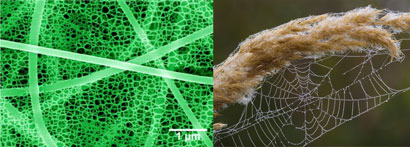A Journal of Materials Chemistry paper has been highlighted in Chemistry World:
Chinese and US scientists have designed a nanofibre net structure to coat a quartz crystal microbalance to be used as a sensor to detect low levels of indoor gaseous pollutants. The device could be an optimal candidate for applications ranging from sensors to filtration and tissue engineering.
Formaldehyde is used in the manufacture of many polymers, resins and other construction materials. It is also used as an intermediate in soaps and detergents and is widely using in pharmacology and medicine. Formaldehyde is, however, a carcinogenic compound, which has a safe indoor exposure limit of between 60-80 parts per billion over a time period of 30 min. Conventional formaldehyde detection methods, such as chromatography, calorimetry, fluorescence and spectroscopy, suffer from long detection times and low sensitivity and are often expensive. Therefore there is a need for a rapid, low cost and sensitive method for formaldehyde detection….
Read the rest of the Chemistry World piece here, or go straight to the original research paper.

Bin Ding, Xianfeng Wang, Jianyong Yu and Moran Wang
J. Mater. Chem., 2011, DOI: 10.1039/C1JM11847A










